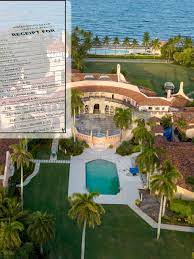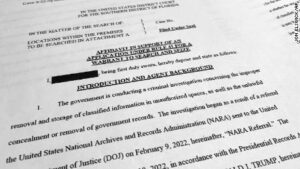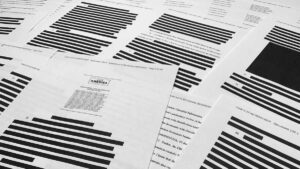
The Justice Department’s use of a redacted affidavit to get a search warrant for former president Donald Trump’s Mar-a-Lago residence has been made public, adding fresh information to the federal probe into the handling of White House records.
The sensitive information discovered in boxes taken from Trump’s Florida club in January was described in previously unreported detail in the court document that was released on Friday. Additionally, it strengthened certain portions of the investigation’s timeframe.
The paper reveals, among other things, that the records that may have been unlawfully handled improperly at Mar-a-Lago held some of America’s most delicate secrets.
Following are key ideas from the recently published document:
According to the FBI, there was probable “proof of obstruction” and secret defense materials.
 Along with explaining to the court that there was “probable cause to believe” that classified national security materials were wrongfully taken to “unauthorized” locations at Trump’s resort, the FBI informed US Magistrate Judge Bruce Reinhart that the search would probably turn up “evidence of obstruction.”
Along with explaining to the court that there was “probable cause to believe” that classified national security materials were wrongfully taken to “unauthorized” locations at Trump’s resort, the FBI informed US Magistrate Judge Bruce Reinhart that the search would probably turn up “evidence of obstruction.”
The FBI affidavit stated that there is “probable cause to suspect” that more documents that include classified (National Defense Information) or that are Presidential records subject to record retention requirements are still present at Mar-a-Lago. “Additionally, there is a good chance that obstruction will be demonstrated at (Mar-a-Lago.) ”
In 15 crates, the FBI discovered 184 sensitive documents earlier this year.

The FBI discovered “184 distinct documents bearing classified marking” when it examined the 15 boxes the National Archives had taken from the Florida resort in May, according to the affidavit.
end of dialogue
In the petition, it is stated that the materials included “67 documents marked as CONFIDENTIAL, 92 documents categorized as SECRET, and 25 documents tagged as TOP SECRET.”
Since he informed the court that “papers classified at these levels often contain” national security secrets, the agent who provided the affidavit made note of the marks on the documents with multiple classified compartmentalized restrictions.
The affidavit added that there were notes that seemed to be scribbled by the former President among the documents.
New information regarding how the DOJ initially became engaged in the document controversy
The FBI affidavit offers fresh perspectives on how the investigation got started. It began after the Justice Department received a criminal referral from the National Archives on February 9.
 The boxes found in January contained “newspapers, magazines, printed news stories, photos, miscellaneous printouts, notes, presidential communications, personal and post-presidential records, and a lot of classified records,” according to what the Archives told the Justice Department.
The boxes found in January contained “newspapers, magazines, printed news stories, photos, miscellaneous printouts, notes, presidential communications, personal and post-presidential records, and a lot of classified records,” according to what the Archives told the Justice Department.
The official from the Archives stated that the lack of properly labelled and “highly classified records were… intermixed with other records” was of “serious concern.”
Redactions conceal obstructive evidence for the time being.
The affidavit contains one unredacted subhead that serves as a hint as to the probable cause the FBI had to think that documents containing secret defense secrets and presidential records were present at Mar-a-Lago.
The following part is largely censored, although the unredacted subhead fits with two of the criminal statutes mentioned in the affidavit’s opening paragraph.
However, the affidavit does not contain a similar unredacted subhead for the third potential crime — obstruction — that was mentioned in the warrant paperwork. The absence of any unredacted information regarding such evidence indicates that that portion of the investigation is no longer being pursued by the FBI. The FBI would have had to explain to the court why it thought there was likely evidence of that crime at Mar-a-Lago. When it comes to making that element of its inquiry public, the department is very careful.





